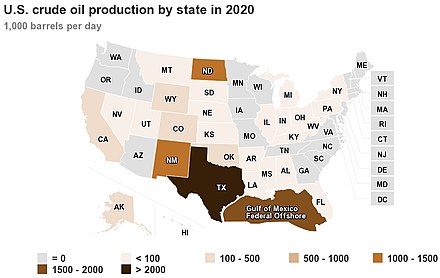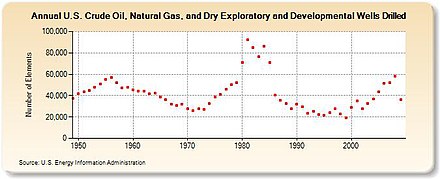






Petroleum has been a major industry in the United States since the 1859 Pennsylvania oil rush around Titusville, Pennsylvania. Commonly characterized as "Big Oil", the industry includes exploration, production, refining, transportation, and marketing of oil and natural gas products.[1] The leading crude oil-producing areas in the United States in 2023 were Texas, followed by the offshore federal zone of the Gulf of Mexico, North Dakota and New Mexico.[2]
The United States became the largest producer of crude oil of any nation in history in 2023.[3] Natural gas production reached record highs.[4] Employment in oil and gas extraction peaked at 267,000 in March 1982, and totaled 199,500 in March 2024.[5]
The United States oil industry is made up of thousands of companies, engaged in exploration and production, transportation, refining, distribution, and marketing of oil. The industry is often informally divided into "upstream" (exploration and production), "midstream" (transportation and refining), and "downstream" (distribution and marketing). The industry sector involved in oil exploration and production is for all practical purposes identical with the sector exploring and producing natural gas, but oil and natural gas have different midstream and downstream sectors (see: Natural gas in the United States).
The term major oil company has no formal definition, but usually refers to a large vertically integrated company, with operations in all or most of the industry phases, from exploration to marketing. Many majors have international operations.
The largest of the majors are sometimes called supermajors. This term is often applied to BP, Shell, Exxon Mobil, Chevron, and Total, all of which operate in the US.
An independent is a company which has all or almost all of its operations in a limited segment of the industry, such as exploration and production, refining, or marketing. Although most independents are small compared to the majors, there are some very large companies which are not vertically integrated, and so are classed as independents.
Service companies contract to oil companies to perform specialized services. Examples are companies that do well logging (Schlumberger), seismic surveys (WesternGeco, CGG (company)), drilling (Nabors Industries, Helmerich & Payne), or well completion (Baker Hughes, Halliburton). There are innumerable small oil (craft oil) producers whose aggregate crude oil production exceeds the aggregate production of major crude oil companies.[6]
In 2009, the production owned by the top ten companies was 52% of total US oil production.[7]

Exploratory drilling, seismic and other remote sensing techniques are used to explore for and find new hydrocarbon resources. Satellites, remote-sensing devices, and 3-D/4-D seismic technologies are some of these technologies. Smaller “slimhole” drilling rigs are able to drill smaller exploratory wells to reduce the size of the impacted area.[8]
Each year, tens of thousands of wells are drilled in search of oil and gas in the U.S. In 2009, 36,243 wells were drilled.


Most modern oil fields are developed with plans to utilize both the oil and the associated gas. Since oil is historically the higher value product, the gas may be viewed as a waste by-product when such plans are delayed, fail, or do not exist. Depending on local regulations, the gas may then be disposed of at the well site in practices known as gas venting and production flaring.[10] In the U.S., a growing volume and percentage of the produced associated gas is intentionally wasted in this way since about year 2000, reaching nearly 50-year highs of 500 billion cubic feet and 7.5% in 2018.[11]<